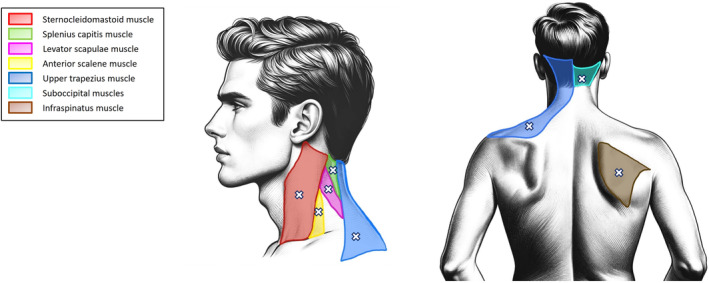- Home
- Protocols
-
All patients were examined by the same researcher, after extensive training and proven experience in the evaluation of myofascial TrPs. The examiner was always blind to the patient's pain status at the time of the examination. On the day of the evaluation, the patient was not allowed to take any analgesics or muscle relaxants. The same muscles were bilaterally explored in all patients. Cervical and upper back muscles that could contribute to the pattern of pain experienced by CD patients (neck, shoulder, upper back, head and/or arm pain) were selected (Fig. 1). 8 , 9 , 10 , 11 To examine for the presence of TrPs, a systematic clinical evaluation was conducted to avoid continuous postural changes in the patient. Thus, the sternocleidomastoid, upper trapezius, splenius capitis, anterior scalene and suboccipital muscles were explored with the patient lying supine, the levator scapulae muscle was evaluated with the patient lying in lateral decubitus, whereas the infraspinatus muscle was explored with the patient in a prone position. The diagnosis was performed according to the following diagnostic criteria: presence of a hypersensitive spot within a taut band of the muscle and referred pain sensation elicited by manual stimulation of the spot. 15 Pressure was applied with a specific technique for each muscle studied: for the sternocleidomastoid and trapezius muscles, the examiner used his thumb and index finger as a clamp; for the splenius, anterior scalene, suboccipital, levator scapulae and infraspinatus muscles, he used his index finger, and for the suboccipital muscles, he applied pressure with the second to fourth fingers of his hand. A TrP was considered active when the evoked referred pain during examination reproduced any symptom experienced by the patient and the pain was recognized as a familiar sensation. 13 A TrP was classified as latent when the evoked referred pain did not reproduce any symptom experienced by the patient and the pain was not recognized as a familiar sensation. 15

Muscles palpated for the presence of myofascial trigger points (TrPs) in this study. See text for more details on the procedure.
Do you have any questions about this protocol?
Post your question to gather feedback from the community. We will also invite the authors of this article to respond.
Tips for asking effective questions
+ Description
Write a detailed description. Include all information that will help others answer your question including experimental processes, conditions, and relevant images.
